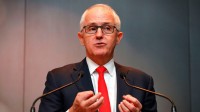ACCC confirms what we already knew about privatisation
Tuesday 31 Jul 2018More than 15 months after Treasurer Scott Morrison directed the Australian Competition and Consumer Commission (ACCC) to “hold an inquiry into the supply of retail electricity and the competitiveness of retail electricity prices” in the National Electricity Market (NEM), we finally have the final report.
For more than a year, Prime Minister Malcolm Turnbull pointed towards this ongoing inquiry to deflect criticism of the skyrocketing energy prices facing the east coast. Only WA and the Northern Territory sit outside of the NEM, so understandably there was a significant amount of interest in what the ACCC report would find.
If you were hoping for a speedy solution, you were out of luck. The ACCC waited until the very last possible day to submit their final report to the Treasurer on 30 June. Then the Turnbull Government sat on the findings for nearly two weeks before finally releasing the report on Wednesday, 11 July.
Given how pressing the issue of power prices has been recently, it’s hard to justify such a lengthy delay to an already lengthy process. But when we actually did get to read the report, we quickly understood why proponents of electricity privatisation were trying to bury it.
The ACCC was eviscerating in their review of the NEM, labelling it “unacceptable and unsustainable”. ACCC Chairman Rod Sims went as far as to call the electricity market “broken”.
The report found that large companies engaged in both electricity generation and retail supply have strong market positions, allowing them to charge large premium on the sale of wholesale electricity to their own retail operations.
If that wasn’t bad enough, the report also identifies the bleak situation facing consumers in the NEM. The retail market has been described as “confusing and unfair”, with “misleading” discounts and on-time ‘discounts’ that turn into harsh late penalties when not met.
The situation is so bad, the ACCC has recommended that the Australian Energy Regulator set a default or benchmark rate for households and small businesses to compare discounts.
So given this situation, surely the ACCC would recognise that privatisation has led to worse outcomes for consumers? Surely they would be compelled to recognise that state-controlled electricity systems are the most reliable and effective way to supply power and keep costs down for consumers and businesses?
Not quite. The report suggested that there was a case for government funding to support bringing in new dispatchable generation from players without a large market share.
How did we reach this farcical position, where the solution to the failure of privatisation becomes more privatisation? Why would a government spend taxpayer funds to encourage a private corporation to supply, for profit, what should be an essential service?
It may be a difficult truth for the Turnbull Government to swallow, but the major takeaway from this report is that privatisation has led to higher prices, less reliable power supply, and deep uncertainty for Australians living in the east.
Luckily, WA voters didn’t need an expensive government report to tell them this. They already knew that electricity privatisation fails consumers and businesses and they made their voices loud and clear at the 2017 State Election.
It’s clear that the only way to avoid falling into the trap of privatisation and repeating the mistakes of our eastern neighbours is to keep our electricity system in public hands.

